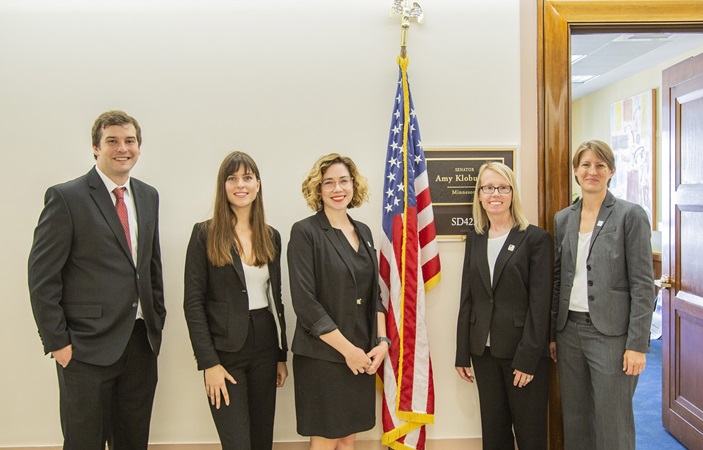
Meet with lawmakers
Preparing for a successful visit
It can seem a little intimidating to think about meeting with your member of Congress, but a study from the Congressional Management Foundation found that visits with your policymakers have more power than you may realize. Almost all the congressional staff surveyed said that constituent visits to the Washington office (97 percent) and to the district/state office (94 percent) have “some” or “a lot” of influence on an undecided member of Congress, more than any other influence strategy. So, whether you meet your local legislators in your home district or federal policymakers in Washington, D.C., our toolkit will help you prepare for a successful visit.
If you don’t have time for an in-person visit, you can still reach your legislator with a phone call or email.
Visit our Policy Action Center
AGU’s Policy Action Center makes it easy for you to contact your legislators about important science policy issues.
Act NowPreparing for and conducting the meeting
Finding contact information
Asking for the meeting
Call and ask to set up a meeting with the member of Congress or their relevant staff who works on the issue you’d like to discuss. You can also ask for that staffer’s name; once you have their name, send them an email at the standard House and Senate email addresses. House staffer emails are structured: [email protected] (for example:[email protected]) and senate staffer emails are structured as [email protected] (for example: [email protected]). When requesting a meeting, staff will always appreciate brevity. In your email, be sure to touch on:
- Where you’re from (tell them if you’re a constituent!)
- What you work on (use clear language, no jargon)
- What issue you’d like to discuss
- When you’d like to meet
Knowing who to bring
Timing your meeting
Researching your member of Congress
To prepare, brush up on your member’s positions on science bills and issues, their recent actions, and what the latest science policy issues being discussed on Capitol Hill are. Pay special attention to the following:
- Member’s website: What committees do they serve on, what are their positions on various issues, and what is their recent voting record? Even if you disagree with most of what your member does, finding something they’ve done recently that you can thank them for it is a great way to begin a meeting. On their website, review the following:
- Member biography
- Committee and caucus membership
- Issues pages
- Press releases
- Social media: Check the member’s Twitter, Instagram and Facebook feed to see how your member views the latest issues being considered by Congress.
- Congress.gov: This site shows each lawmaker’s recent voting record and bills they’ve introduced (sponsored) or co-sponsored.
Mapping our your "ask"
Crafting your message
It’s important that you clearly explain to the member or staffer why your ask should matter to them, and this is where your message comes in. How can you frame your message to make them care?
Some questions to ask yourself while creating your message:
- What impacts have your science or program had on the state or district?
- Did your program recently discover something? Have you been recognized or awarded recently? Does your university stimulate your area’s economy and bring in constituents?
- What are the congressperson’s values (e.g. sustainable agriculture, national security, a strong economy, public health)? How can you connect those values to your science? For example, if your member of Congress is passionate about STEM education, you could discuss how excitement about science gets kids interested in STEM and makes them more likely to eventually pursue a STEM career.
- What’s the personal story behind your science? Did your program bring you to the area? What sparked your interest in science?
Crafting a leave behind
Structuring your meeting
Here’s a sample of how a meeting might be structured:
- Exchange business cards and very briefly introduce yourself and others in the group.
- Thank the staffer for meeting with you, and for any positive actions the congressperson has taken recently that you’ve supported.
- State your ask – what’s the explicit goal of the meeting?
- Share your message – why do you want what you’re asking for? Why should they care?
- Spend time listening to the staff person and answering their questions.
- Share your leave behind and thank the staffer for their time.
Meeting etiquette
-
1Identify yourself as a scientist and, if applicable, a constituent.
-
2Specify the policy issue or bill you are contacting them about.
-
3
If applicable, thank them for their past work on this or another issue.
-
4
Tell them what you want them to do about (support or oppose) the issue or bill.
-
5
Provide additional details about why they should support or oppose an issue or bill and how their district will be negatively or positively affected by it.
-
6
Offer to be a resource on this issue.
-
7Thank them for their consideration and let them know you will follow up with them as the issue moves forward.

After the meeting


